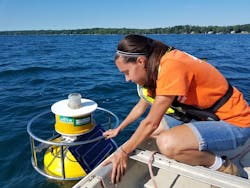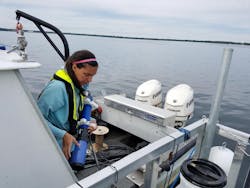USGS to study harmful algal blooms in New York
WASHINGTON, DC, MAY 17, 2019 -- This week USGS scientists, with support from the New York State Department of Environmental Conservation, installed technologically advanced monitoring systems to study water-quality conditions and harmful algal blooms -- known as HABs -- in Owasco and Seneca lakes. In the next several weeks, instrumentation will also be installed on Skaneateles Lake.
This monitoring effort will provide a better understanding of HAB growth and severity and allow for near instantaneous detection of changing water-quality conditions that might be indicative of HAB development. This will enable state officials, water resource managers, drinking water utilities, the public and others to make more informed decisions on how to deal with HABs and develop mitigation strategies.
"Most algal blooms are harmless, but in some cases, something is triggered to overwhelm the system, which leads to potentially harmful blooms that deprive aquatic organisms of oxygen. HABs also can produce toxins that pose health threats to humans and other organisms coming into contact with them," said Guy Foster, USGS New York HAB project lead. "USGS research capabilities are being deployed to figure out the environmental conditions and processes that result in the formation of HABs, their growth and severity. In addition, new monitoring techniques are providing near instantaneous detection of when the public could be exposed to a potentially harmful algal bloom."
Aesthetic problems and potential health risks associated with HABs have hurt local economies through depressed real-estate values and reduced recreation and tourism. Other economic impacts include loss of fishery revenues, closure of municipal water supply intakes during HABs and the cost of alterations to drinking-water treatment processes.
HABs are believed to be caused by natural and man-made influences. Scientists believe that the formation of HABs is related to the interaction of nutrients—such as fertilizer, waste products, dust and leaves—as well as light, temperature, water quality, shifts in the types of algae present, human activity and possibly other factors impacting the system.
"The exact causes of HABs are unknown and represent an active area of research," said Foster. "In support of the state of New York's initiative, the USGS and DEC have installed some of the most technologically advanced and robust monitoring platforms ever to be deployed in the nation to monitor water quality and the development of HABs."
Over the next few years, the USGS will continue to deploy these sophisticated new monitoring technologies in other high-priority watersheds throughout the nation as part of its Next Generation Water Observing System. These data will help the United States better understand the amount of water available for human and ecological needs and where water supplies may be threatened in the future.
The nutrient sensors measure concentrations of phosphorous and nitrogen, as those are two of the most important "food" sources for algae. Understanding the amount of nutrients available, and how that availability changes over time, may be related to observed algal growth and accumulation. This will give insight on why HABs form, why some grow quickly and some don't and why some produce toxins while others don't.
Fluorometers measure chlorophyll, other algal pigments and dissolved organic material in water that can be used to detect and monitor changing conditions that may be indicative of HAB formation.
The USGS built the monitoring platforms in 2018 and the first set of instruments was deployed in September, with USGS staff focused on training, operating procedures and maintenance. The platforms were retrieved during the winter to avoid weather damage, and they were reinstalled this week to start collecting data.
"We need a few years of research since a wide range of conditions is preferred to analyze and interpret data," said Foster. "With that said, each day will bring us new insight -- with the highest quality data to date -- and a better understanding of HAB development, duration and decline."
While there have been an increased number of observed HABs worldwide, it isn't clear whether HABs are increasing in size and occurrence or if heightened awareness has led to more people observing and reporting HABs. This research and other projects underway will help answer that question, too.
While this USGS research is focusing on three lakes in New York, HABs have occurred and concerns exist in other locations across New York. The three selected Finger Lakes were recently affected by HABs and represent a range of nutrient and water-quality conditions. The DEC has a website that lists the location and duration of HABs reported at any given time in New York.
This work grows from more than a decade of USGS science on HABs, and the USGS brings together scientists from many different disciplines in its HAB research efforts across the nation.



